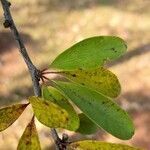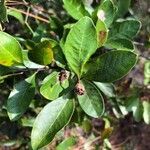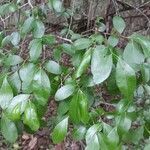Shrubs or trees, to 15 m. Stems not armed or armed, villous, glabrescent. Leaves deciduous; petiole 2-14 mm, villous or sparsely hairy to glabrate; blade (dull to lustrous adaxially), oblong or oblanceolate to spatulate, 15-97 × 7-40 mm, base acute to attenuate, margins plane, apex rounded to obtuse, rarely acute, abaxial surface usually villous, rarely glabrate, venation visible, midrib villous (hairs white or gray to tawny, entangled, wavy), adaxial surface glabrate (hairs scattered along midribs), midrib flat, marginal vein absent. Inflorescences 7-17-flowered. Pedicels 2-7 mm, villous, rarely glabrous. Flowers: calyx 1.9-3.2 mm diam.; sepals (4-)5, 1.8-2.8 × 1.4-1.9 mm, lanate-villous; petals (4-)5(-6), white, median segment oblong to ovate, 1.2-1.8 mm, lateral segments lanceolate or falcate, 0.8-1.8 mm; stamens 5(-6), 2.5-2.8 mm; staminodes lanceolate, 1.3-2.5 mm, entire or erose; anthers sagittate, 0.8-1.2 mm; pistil 5(-8)-carpellate; ovary 5(-8)-locular, 1-1.2 mm, strigose; style 1.1-1.5 mm. Berries purplish black, broadly ellipsoid to obovoid, 7-12 mm, glabrate. Seeds 6-11 mm.
More
A tree. It grows 18 m high. It is usually smaller in cultivation. It loses its leaves in cooler regions but stays evergreen in warmer places. It has a tall narrow crown. The bark is scaly and dark brown. The leaves are small and blunt tipped. They are shiny dark green on the upper surface and are densely woolly underneath. The flowers are 3 mm wide. They are bell shaped and have a 5-lobed white corolla. The fruit are purplish black. They are 12-25 mm long.




